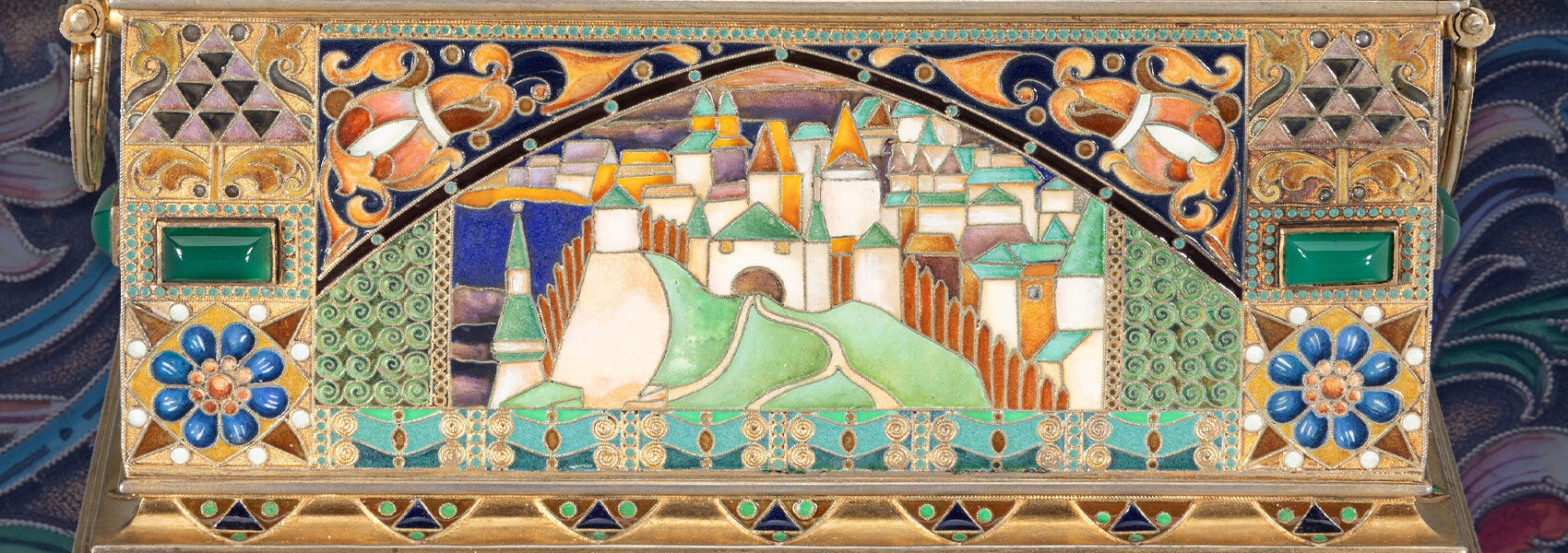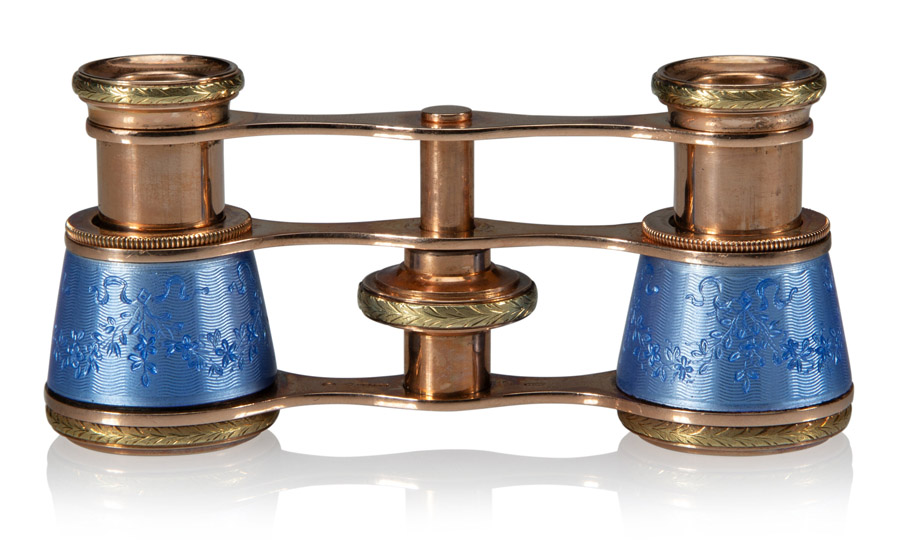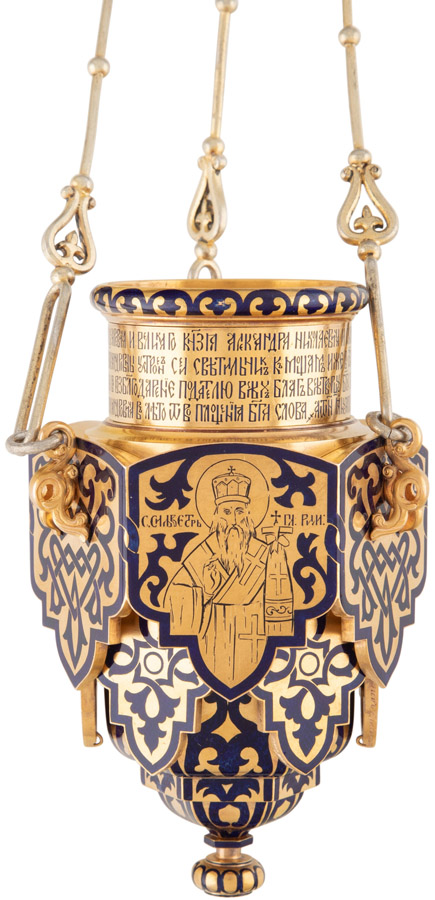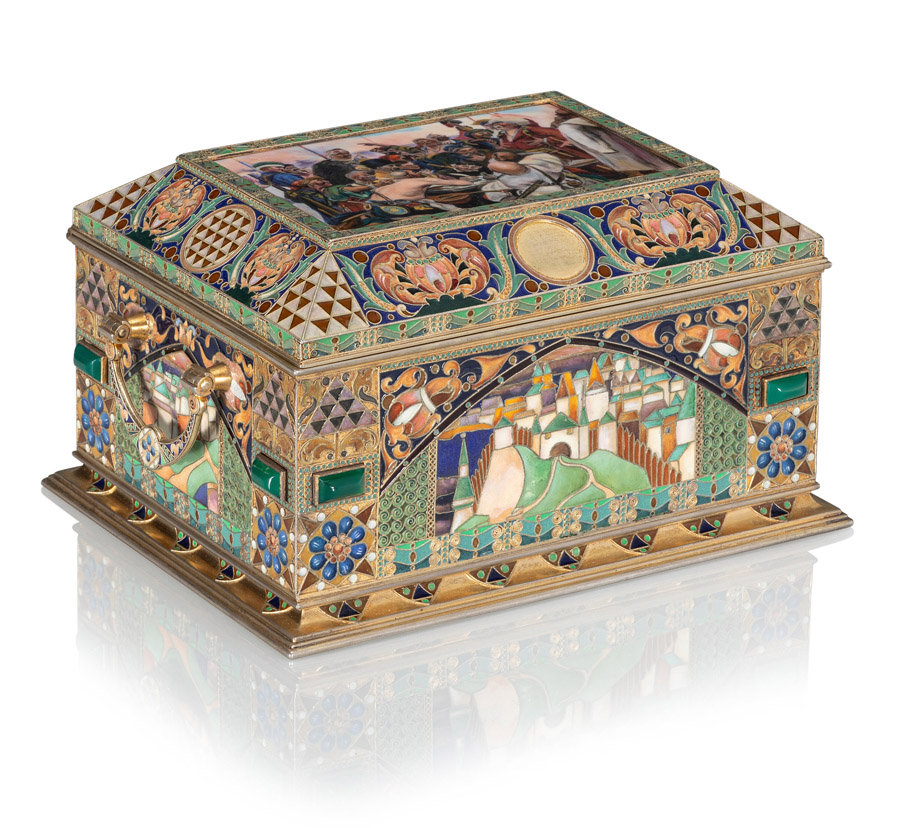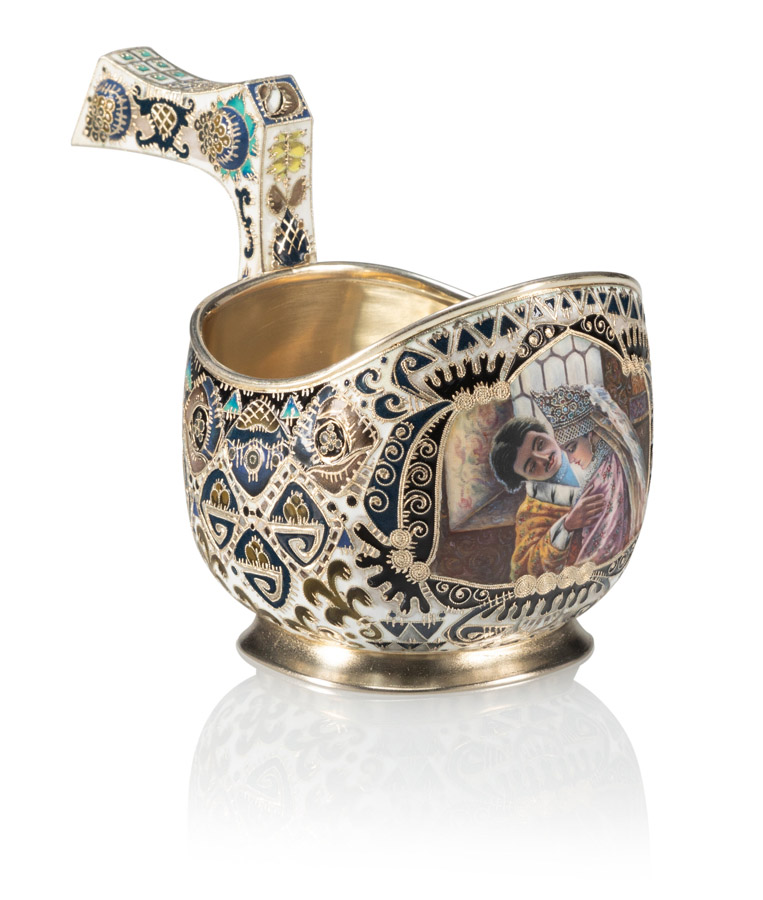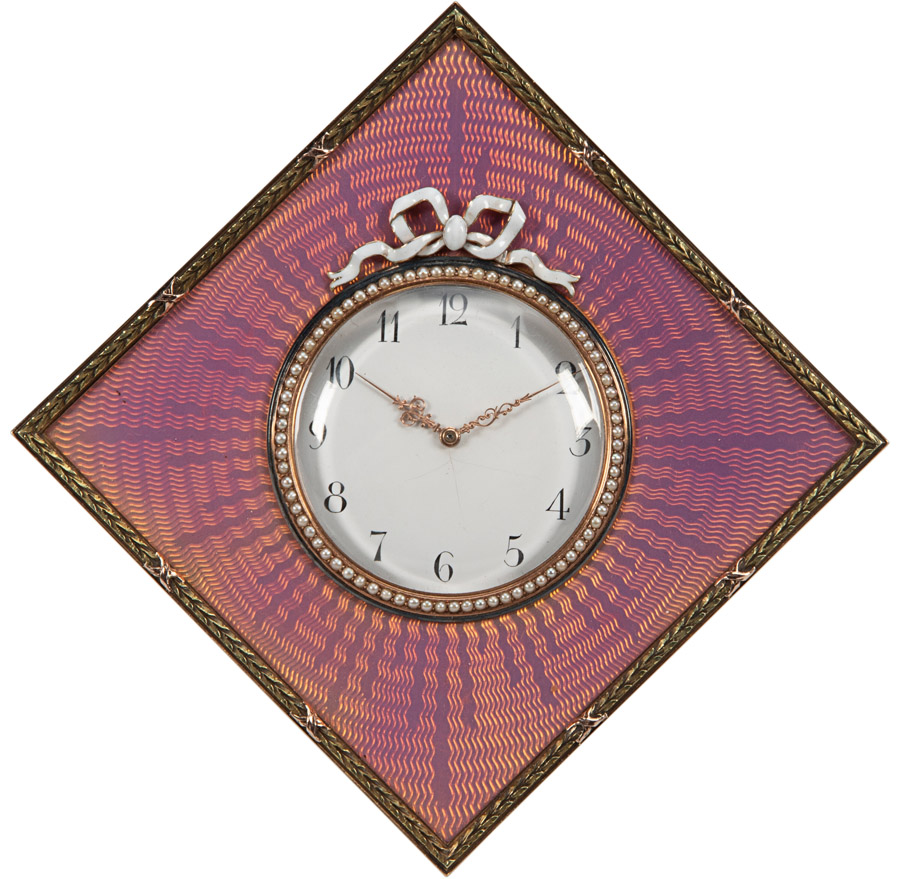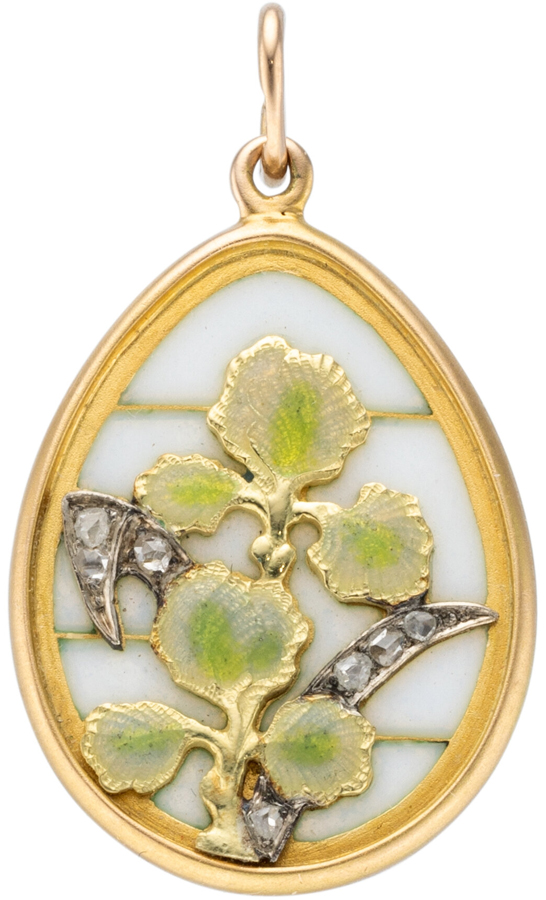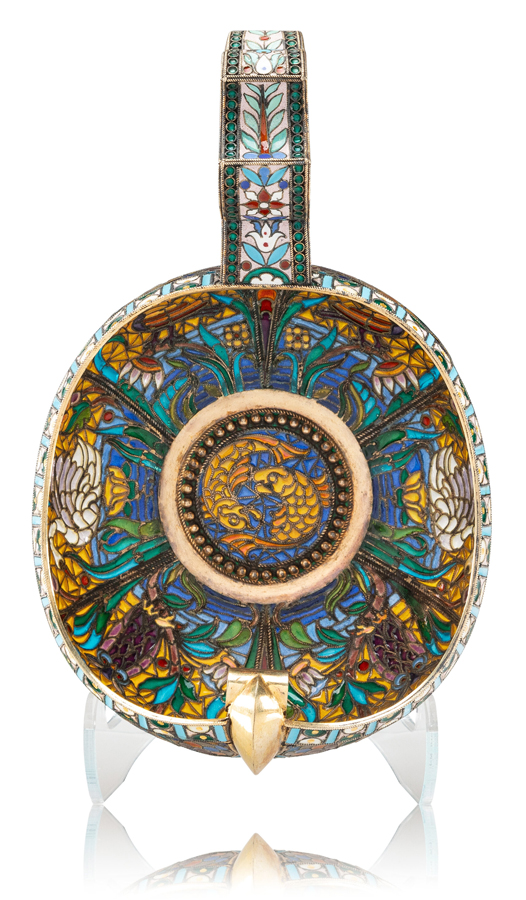FROM CLOISONNÉ TO CHAMPLEVÉ, GET TO KNOW THE CELEBRATED ART FORM’S SIX MAIN TECHNIQUES
By Nick Nicholson
The history of Russian enamel begins with Byzantium. In 1453, Constantinople, the capital of the Byzantine Empire, fell to Mehmed the Conqueror. What was left of the Imperial family was forced to flee, and with them, the 4-year-old Princess Zoe Palaiologina, daughter of the last despot of Morea and niece of the last Emperor Constantine XI. Almost 20 years later, this last Byzantine princess married Ivan III, Great Prince of Moscow. Bringing a retinue of Byzantine servants and craftspeople with her, the Great Princess Sophia became an arbiter of style and taste and sought to re-create the opulence of the Byzantine imperial court in Moscow.
Some of that grandeur came from the creation of gold and enamel workshops in the Moscow Kremlin, which began to produce new works using Byzantine techniques. As time went on, the Russians became known for their work in this medium, and Russian enamels began to travel around the world – given as diplomatic gifts in the 16th to 18th centuries and purchased at home and abroad by devotees in the 19th to 21st centuries.
Here, we look at the six main enameling techniques seen in Russian work, along with superlative examples of each that have crossed the block at Heritage Auctions.
These Fabergé opera glasses from circa 1908 feature a combination of basse-taille and guilloché work. The pair realized $36,250 in a May 2024 Heritage auction.
Basse-Taille
Basse-taille enameling is a technique in which a design is engraved or carved into a metal surface, usually silver, gilt silver or gold, creating a line design or image of varying depths. These engraved areas are then filled with translucent enamel, allowing light to reflect through the enamel from the metal beneath, enhancing the depth and brilliance of the design. Basse-taille was first used in Byzantine and Romanesque jewelry and art, but the technique continued well into the 20th century when Fabergé used it. In May 2024, Heritage sold an extraordinary pair of opera glasses from The Nelkin Collection that featured a combination of guilloché and basse-taille work. In these glasses, the background is in guilloché, and the flower garlands were done in basse-taille by hand.
This Imperial champlevé enameled gold and gilt silver icon lamp designed in 1850 by Feodor Grigorievich Sol’ntsev sold for $475,000 in a May 2024 Heritage auction.
Champlevé
In the champlevé enamel technique, recesses are carved, etched or cast into a metal surface to create a pattern or design. These recessed areas are then filled with either opaque or translucent enamel, while the raised portions of the metal remain exposed, forming part of the design. Once the enamel is fired and polished, it creates a smooth, colorful surface contrasted with the exposed metal. A superlative 19th-century example of champlevé enamel can be found in the icon lamp ordered by Tsesarevich and Grand Duke Alexander Nikolaevich (later Emperor Alexander II of Russia) for the Tomb of St. Alexis in the Chudov Monastery of the Kremlin, which sold at Heritage in May 2024.
This en plein and cloisonné enameled gilt silver casket after Ilya Repin’s ‘Reply of the Zaporozhian Cossacks’ realized $625,000 in a December 2024 Heritage auction.
Cloisonné
Cloisonné enameling involves thin metal wires or strips being soldered onto a metal surface to create compartments or “cloisons” in a desired pattern or design. These compartments are then filled with enamel, fired and polished to produce a colorful, intricate pattern with the metal outlining each section. Traditional Russian cloisonné used a palette of opaque enamel colors like cobalt, red, white, turquoise, black, pink and green. In the late 19th century, the technique of “shaded” cloisonné enamel evolved, in which multiple colors of enamel were painted into each cloison, giving a richness and depth of detail and color, which is the hallmark of Russian enamel. Perhaps the most stunning and unusual example of cloisonné enamel was the casket by Khlebnikov that Heritage sold in December 2024 as part of the Masterpieces of Russian Enamel collection.
Feodor Rückert often drew inspiration from the historicist paintings of Konstantin Makovsky to adorn the en plein reserves of his enamel works. This extraordinary kovsh, which sold for $262,500 in a December 2024 Heritage auction, is one such example.
En Plein
En plein enameling is a technique where enamel is applied directly onto the metal surface without any divisions or borders, covering it entirely. Often, a white enamel ground is applied as with gesso on a canvas, and then colored enamel is painted on the prepared surface as if it were a miniature work in watercolor or oil. The enamel is then fired, creating a smooth and uniform finish, appropriate for figural paintings in miniature. Enameller Feodor Rückert was the greatest master of this technique, and in 2024 Heritage sold more than a dozen works in en plein enamel by Rückert. This exquisite kovsh with a detail of Konstantin Makovsky’s A Boyar Wedding Feast shows how effective the technique is even on a rounded surface.
This diamond-shaped clock with an opalescent pink guilloché ground is the epitome of Fabergé’s work in the Louis XVI revival style at the turn of the 20th century. The clock realized $300,000 in a May 2024 Heritage auction.
Guilloché
Guilloché enamel is a decorative technique that combines intricate, repetitive patterns engraved onto a metal surface by machine or by hand with a layer of translucent enamel applied over it. Developed in 18th-century France with the advent of machine engraving, the technique reached its height under Fabergé. The enamel enhances the engraved design by allowing the pattern to shine through, creating a shimmering, textured effect. A clock from the collection of Grand Duchess Xenia Alexandrovna, which sold in a May 2024 Heritage auction, shows the harmony and brilliance of true guilloché technique, with a machine-engraved guilloché ground shimmering beneath layers of colored translucent enamel that combine to make one of Fabergé’s rarest colors, salmon pink.
This Fabergé gold and plique-à-jour enameled pendant sold for $11,250 in a May 2024 Heritage auction.
This plique-à-jour and cloisonné enameled gilt silver kovsh realized $25,000 in a December 2024 Heritage auction.
Plique-à-Jour
Plique-à-jour enamel is a very difficult technique in which translucent or transparent enamel is applied into cells without a metal ground or backing, creating a stained-glass effect when light passes through the object. The design is typically crafted using gold, gilt silver or silver to form the framework, and the enamel is fired in place to create vibrant, luminous colors. This technique is highly valued for its intricate craftsmanship and striking visual appeal and may be seen in small pieces of jewelry as well as in large-scale objects. Heritage’s May 2024 sale of Russian Works of Art featured a pendant in plique-à-jour whose twin is in the Royal Collection, and in December 2024, Heritage offered an exceptional kovsh that is an important example of the technique.
Caring for Your Collection
Russian enamels are fairly durable, but they can chip and scratch. It is important to keep enamels in a location without extreme light and at as close to a constant temperature and humidity level as possible. Sudden changes in temperature from extreme low to extreme high can cause the underlying metal structure to expand and contract, which can cause hairline cracks and flaking.
Cleaning Russian enamels should only be attempted by a conservator or trained restorer familiar with such materials. Abrasives (such as silver or gold polish) should not be used, and enamels should never be placed in a sonic cleaning machine. A soft cloth or microfiber sheet is the best way to gently clean the surface. If a deep cleaning is required, a professional will use the required solvents to lift away organic matter – dirt, oils, residue, tarnish, oxidation – without interfering with the surfaces of the enamels or the gilding of the silver.
► More Collector’s Guides
For additional collecting advice on topics ranging from fine minerals and rare books to art glass and action figures, visit our dedicated Collector’s Guide page.
Forgeries
With prices for fine Russian enamels ever on the rise, copies and outright forgeries have begun to creep into the market. Most are poorly made and relatively easy to spot, but some very sophisticated copies have begun to appear. Sometimes these works are based on famous examples, but often they are pastiches, combining elements from one work with elements of another. A proliferation of Imperial eagles and Romanov crowns may cover these works, and so documented provenance is of paramount importance.
Also look at the enamel work itself. Are the cloisons full of enamel and carefully detailed? Or are they shallow and sloppily painted? Is the white enamel clear and bright, or is it full of the black specks of soot associated with poorly maintained commercial kilns? Finally, is the work offered by a reputable auction house or dealer at a price commensurate with auction records? Or is it a “deal” you can’t afford to pass up? Caveat emptor!
 NICK NICHOLSON is Director of Russian Works of Art at Heritage Auctions.
NICK NICHOLSON is Director of Russian Works of Art at Heritage Auctions.

